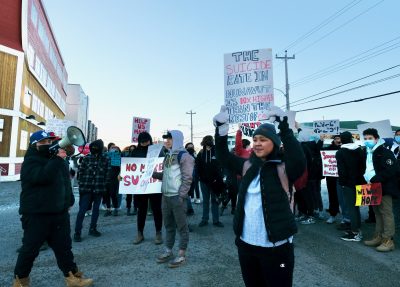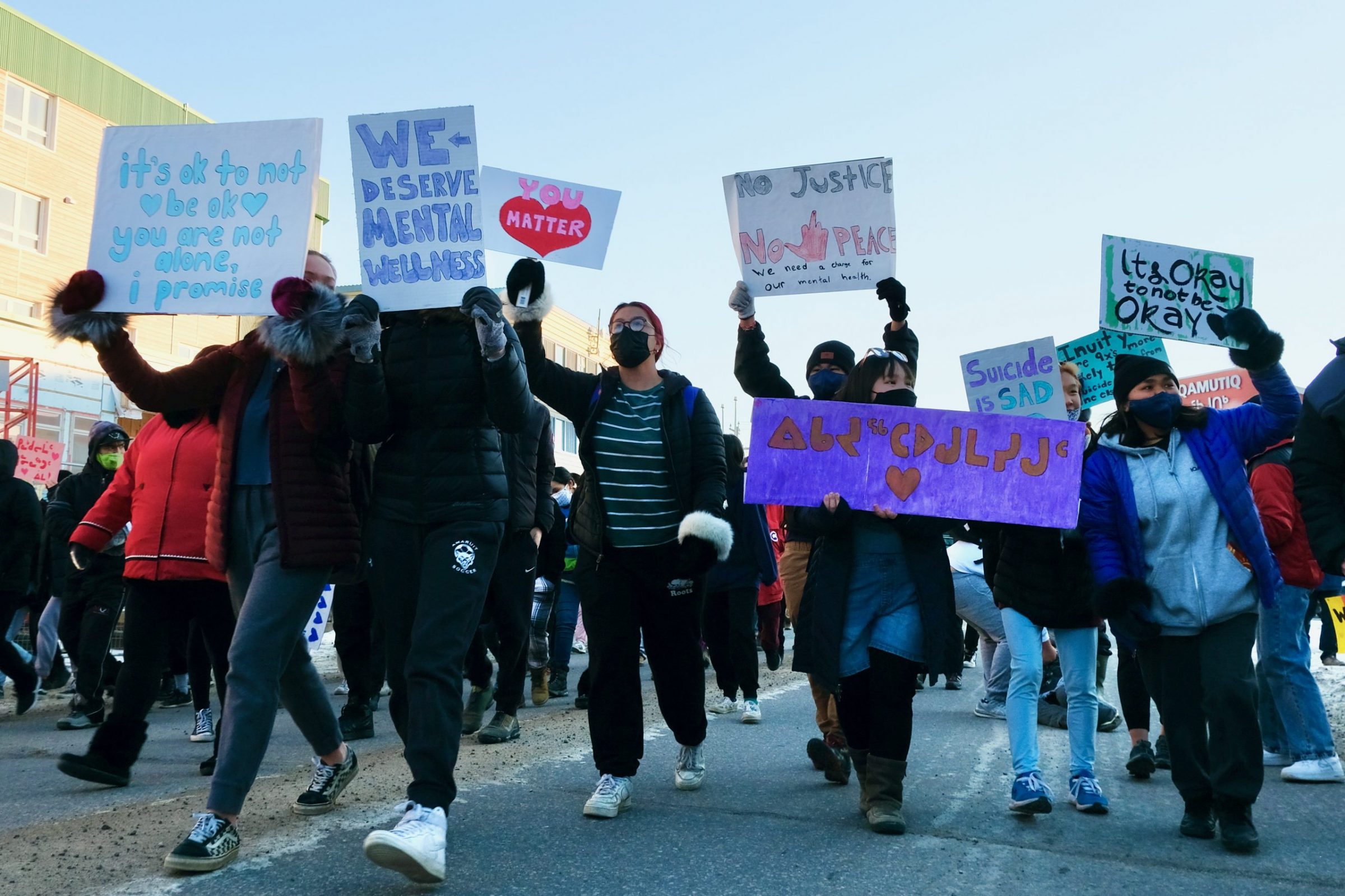Iqaluit youth protest calls for improved mental health supports
‘It’s to the point where we’re wondering who’s next,’ says Grade 12 student Minnie Akeeagok
Iqaluit’s youth took the the streets on Tuesday to demand the federal government’s help in reducing the rate of suicides in Nunavut. (Photo by Mélanie Ritchot)
Iqaluit’s busiest intersection was blocked by high school students chanting, “We want change” Tuesday afternoon.
Over 100 students, parents and local politicians marched from the Four Corners to the legislature, where they filled the lobby and tried to make their pleas heard for more mental health resources and suicide prevention.
“It’s to the point where we’re wondering who’s next,” said Grade 12 student Minnie Akeeagok, who attended the protest.
“If you go to any person and ask if they know anyone who died from suicide, they will surely have at least two to 10,” she said.

Iqaluit youth filed into the legislature lobby on Tuesday to share stories, speeches and hopes for better mental health resources. (Photo by Mélanie Ritchot)
Signs displaying suicide statistics, words of encouragement and urgent demand for more support for Nunavut youth peppered the crowd.
“The kids aren’t alright,” said one sign.
Others wrote, “We deserve mental wellness,” and, “How many more until we’re finally listened to?”
Resources for Nunavut students are limited compared to what’s available in Canada’s provinces, Akeeagok said.
“They have in-person help that they could reach out to and here, we have hotlines.”
She said not everyone is comfortable speaking with a stranger about their mental health concerns over the phone, and sometimes their peers aren’t comfortable talking about it.
“You have no one else to turn to,” she said.

Amy Ullikatar stood in the middle of the four corners intersection holding a sign that states statistics on suicide rates in Nunavut. (Photo by Mélanie Ritchot)
Grade 12 student Amy Ullikatar said she joined the protest to show support for her community and show the government that Nunavummiut want more access to mental health services.
“I’ve experienced losing a loved one to suicide and it’s really, really devastating losing someone that way,” she said.
Ullikatar said if she or her peers were to try to get mental health support, there are hotlines to call, but in-person services aren’t available every day of the week and aren’t accessible at all hours of the night.
“What if I feel bad on a day it’s not open,” she said, “or if there’s someone who’s not able to go during the day because of work?”
Some of the highest rates of suicide in the world are reported in Canada’s Inuit population, with most instances happening among youth, according to the Canadian Journal of Psychiatry.
The suicide rate among Inuit was nine times higher than in non-Indigenous populations between 2011 and 2016, when 250 deaths by suicide were reported by Statistics Canada.
In January, Iqaluit’s mental health and addictions team began taking same-day appointments three days a week.
“It’s really challenging with the hours they provide us with,” Ullikatar said.
In most communities outside of the territory’s capital, mental health resources are available at local health centres.
One of the organizers, Deion Pearce, said a place for youth to go 24-hours of the day is also needed.
“When times at home are tough, there are many children who just walk around at night and have nowhere to go,” he said.
“It’s about time we get what we deserve,” Pearce said.

Joseph Ashoona (left) and Deion Pearce (right) spearheaded the march for mental health in Iqaluit on Tuesday. (Photo by Mélanie Ritchot)
Another organizer, Joseph Ashoona, said he hopes the federal government will see the need for a mental health facility and more resources in Iqaluit.
“With the proper help from the Canadian government, I have a feeling we could make a change, and we could stop these suicides from happening in our town,” he said.
“I just don’t want my grandchildren to go through the same thing I went through and live in this struggle with our mental health issues,” Ashoona said.
He said this is just the first step and he plans to organize more protests in the future and keep raising awareness for suicide prevention.
On Friday, Rankin Inlet students are expected to gather for a similar protest, said resident Meagan Netser.
Iqaluit residents can request same-day mental health appointments Monday, Wednesday and Thursday by calling 867-975-5900 when the clinic opens at 8:30 a.m.
If you’re experiencing emotional distress and want to talk, call the First Nations and Inuit Hope for Wellness Helpline at 1-855-242-3310 or chat online at hopeforwellness.ca. Those resources operate 24 hours a day, seven days a week.







What is with the “No Justice, No Peace” sign? I think you might be at the wrong protest?
The phrase seems appropriate. The causes of suicide are unjust. There should be no peace until needs are met.
This phrase doesn’t belong to one cause.
Can you give us an example of how the causes of something like clinical depression are unjust? Are they always unjust, or can depression ever be the result of bad luck (unfavorable brain chemistry due to genetics for example)?
It’s a complex issue, to be sure… Yet here you are, using this as an opportunity to advance a social justice narrative while dropping absolutist statements like an expert. Your comment feels a lot like politics and opportunism to me.
Maybe you could expand on this?
Colonialism is unjust. Not facing the ramifications of intergenerational trauma is unjust. Suffering under climate change is unjust. If suicide is not a social justice issue I’d love to hear you expand on what it is instead.
Re the rather absolutist and off-the-mark question posed (“Are they always unjust, or can depression ever be the result of bad luck (unfavorable brain chemistry due to genetics for example)?”)- Absolutely depression can be genetic. Intergenerational trauma is also genetic. No one that I have seen is arguing against supporting those who are chemically depressed.
#NoPeaceUntilJustice is absolutely an appropriate slogan for the disproportionate suicide rates of Inuit youth.
Just to confirm; the “new northerner” is here to explain how things work in the north.
Interesting how you have tried to curve the terms here toward a more favourable interpretation.
The slogan we are discussing is not, as you pretend it to be #NoPeaceUntilJustice it is “No Justice, No Peace” and that carries a clear threat of violence until certain political aims are met.
I am so pround of you all, the youth, for taking a stand! I wish I could have been in town to join you all in this protest. Aakuluuvusii illunnasii! Keep speaking up, keep making noise! You will be heard and you are making a difference!
I think there is a whole unit and a suicide epidemiologist over at health who deal only with suicide and I think education also has well paid people doing this work maybe you can write a bit on what they are up to? If they do nothing get rid of the waste and give it to the kids.
Whenever something bad happens, people like to shout at the government to do something. They think that throwing money at having mental health workers to speak to in person will solve the issue, the same way people think having an addictions rehab centre will solve that issue.
.
In reality, suicide rates in Canada as a whole have been relatively stable over time, with the 2017 rate being 11.3 per 100,000 population, the same rate as 1970. This is despite the fact that there are infinitely more mental health resources now than 50 years ago.
.
Suicide rates are not something that a government can just “fix” by throwing money at it. Most of the time it starts at home.
This is the type of research we need to understand better as it relates to how to apply resources in the best way
it would be good to find out how much money is being spent on suicide prevention and the success of it. it seems so much money is spent but we dont know if its doing anything. paper could write something about this to help us understnad better
#HOUSING FIRST!
Services in general are severely lacking in Nunavut, there’s no doubt. Much of this can be blamed on how remote the Territory is, the lack of suitable staff housing, cost of adequate infrastructure, the xenophobia towards “southerners”, and often unfair working conditions.
They want in-person mental health services available 24 hours a day?
1. That means you need to find 3-4 Mental Health Workers (likely southerners), to move to each community in Nunavut, house them, and pay them likely somewhere around $140k /year
2. What makes you think that the needed 100 people want to fill these roles in Nunavut when there are vacancies and nursing staff shortages everywhere in Canada right now.
3. What ever happened to “we need a traditional solution to the mental health crisis”.
Its one thing to point out the issue, but the solution needs to be solved as a whole. A wholistic approach between the government and the people needs to be looked at. Out of all these young peoples pointing out the problems, how many are looking to go to school to become mental health workers in their own communities? We need to stop thinking southerners will come and fix everything for Nunavut.
One key factor that is often kept silent is the advancement of Social Media in Nunavut and its impact on our young. Facebook is a dangerous place for someone with Mental Health problems.
Look at Vancouver, people are dying everywhere from the Opioid crisis at alarming rates, and a large percentage of those affected are indigenous peoples. There are all the services available in the world there, yet the numbers of deaths from overdoses keeps increasing every year.
I am an Inuk person with many problems. I seeked help for my problems. I did not get the help that I needed. The mental health workers are scarce. In smaller communities you’re left to deal with one nurse. Imagine how burnt out that nurse may be. Do they not have the power to ask for more mental health workers in their health centres?
Inuit of Nunavut please if you can’t get help from someone seek someone else. I have a great round of co workers that help me deal with my problems. Although it’s not their job it’s someone I trusted. Let your feelings out to someone you trust. And when you get out of this state maybe you have the tools to help other Inuit ppl? Apply for a course if you’re able to. There’s courses to become mental health workers. Courses to become nurses. Teachers. FANS funding Q/K/KIA all have funding to help you accomplish what you want to do. Take full advantage of that free money to go to school. Also childcare is paid for. Take advantage of that as well.
If we really need help. Let’s help each other to become mental health workers, nurses, teachers that will be able to help us get to the happiness that you want. Sometimes it’s hard to work with “southerners” cause they don’t understand our way of life. Perhaps if we had Inuit in these jobs we’ll be able to help Nunavut become a better territory. Let’s thrive together.